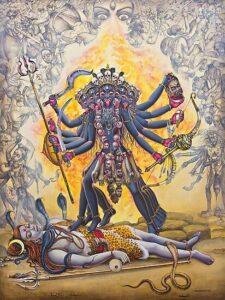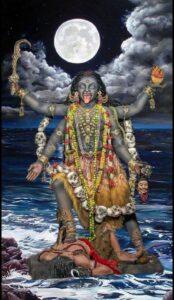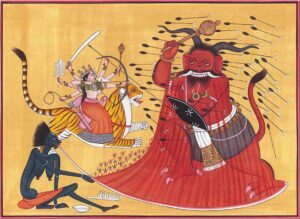Table of Contents
Kali, a prominent deity in Hindu mythology, presents an intriguing blend of nurturing and ferocity. Revered as a mother figure and a symbol of death and time, her complex character encapsulates the dualities of life itself. This exploration delves deep into Kali’s origins, stories, symbolism, and her significant role in Hindu culture and beyond, offering a vivid picture of this enigmatic goddess.
Who Is Kali?

Kali, often depicted as a motherly figure, embodies the nurturing aspect of creation. Yet, her more dominant portrayal is as the goddess of death and time, a role that ties her to the themes of destruction and transformation. Her associations with violence and sexuality mark her as a deity of power and change.
She is the reincarnation of Parvati, the wife of Lord Shiva, and embodies Shakti – the essence of feminine energy, fertility, and creativity. Kali’s dual nature as both a creator and a destroyer positions her as a central figure in Hindu mythology, offering insight into the religion’s understanding of the cyclical nature of the universe.
Origins and Names
Kali’s name, derived from the Sanskrit word “Kala,” means “black” or “death,” pointing to her association with eternal darkness and destruction. She is known by several names, including Kaushika, Chaturbhuja Kali, and Chinnamasta, each reflecting different aspects of her nature and mythology.
Worshipped across India, especially in regions like South India, Kashmir, Assam, and Bengal, Kali’s influence extends to both gods and mortals. As an embodiment of time, she represents the consuming force that devours all existence, a concept deeply rooted in Hindu cosmology.
Legends and Stories
The Birth of Kali

Kali’s origins are vividly depicted in various mesmerizing myths, each offering a unique perspective on her emergence. One such myth portrays Kali as a manifestation of the seething wrath of Durga, the formidable ten-armed warrior goddess. In the midst of her fierce battle against the malevolent demon Mahishasura, Durga’s relentless fury gives rise to Kali, who emerges with an insatiable appetite for demons. This extraordinary transformation serves as a symbol of the unstoppable force of anger and power that lies within the realm of the divine.
In another captivating narrative, Kali’s birth is intricately linked to the divine drama of life, death, and rebirth. According to this tale, Kali emerges when Parvati, the beloved wife of Lord Shiva, undergoes a profound transformation. As Parvati sheds her very skin, Kali emerges with a complexion as dark as the night. This astonishing metamorphosis serves as a poignant symbol of the profound connection between the cycles of life, death, and the eternal process of rebirth.
Yet another mesmerizing legend unfolds the story of Kali’s emergence as she assumes her role as a fierce protector and a relentless destroyer. In this narrative, Parvati transforms herself into Kali to confront and defeat the malevolent demon Daruka. It is in this moment of fierce confrontation that Kali’s divine power blazes forth, underscoring her unwavering commitment to safeguarding the cosmic order.
These myths collectively unveil the intricate tapestry of Kali’s birth, offering us a profound glimpse into her multifaceted nature as a goddess of power, transformation, and divine intervention. Through these tales, we are invited to contemplate the profound depths of her existence, forever intertwined with the forces of creation and destruction in the grand tapestry of the cosmos.
Raktabija

Band of Thieves
In a gripping narrative that vividly illustrates Kali’s unwavering commitment to defending righteousness, her intervention unfolds when a group of ruthless thieves, fueled by malevolence, mistakenly target a peaceful monk for a grotesque human sacrifice. As the nefarious plot takes shape, Kali’s divine presence is aroused, and her wrath blazes forth like a tempest.
With a thunderous roar, Kali materializes on the scene, her eyes aflame with righteous anger. The thieves, taken aback by her formidable presence, find themselves frozen in terror as she descends upon them with a ferocity unparalleled. In the blink of an eye, her gleaming sword slices through the air, and the heads of the malevolent criminals roll to the ground, their nefarious intentions abruptly severed.
This dramatic encounter serves as an indelible testament to Kali’s impulsive and relentless temperament, as she spares no mercy for those who would dare to perpetrate acts of darkness and injustice. Her actions stand as a stark reminder that she is not only a symbol of destruction but also a fierce defender of righteousness, prepared to unleash her wrath upon those who threaten the balance of the cosmic order.
Through her decisive and uncompromising actions, Kali reaffirms her role as a guardian of morality and a protector of the virtuous, ensuring that justice prevails in the face of malevolence and chaos.
Family and Relationships
Kali, as the consort of Shiva, represents the dynamic aspect of the divine partnership. In contrast to Shiva’s embodiment of silence and passivity, Kali personifies action and energy. Their union serves as a profound symbol of the interplay between dynamic and static principles, which is essential for maintaining the cosmic balance. From a spiritual perspective in Hindu thought, they are viewed as a unified, all-encompassing force, highlighting the harmony between the active and contemplative aspects of the divine.
Artistic Representations
Kali’s depictions vary, often showing her with black or blue skin, symbolizing the infinite nature of the universe. She is typically naked, adorned with a clay crown, symbolizing her detachment from the material world. Her multiple arms, ranging from four to eighteen, each hold symbolic objects like a sword, trident, or drum, denoting various aspects of her power and nature.
Her postures in art vary significantly. In some, she is slaying demons, while in others, she stands atop Shiva, embodying her dominance over time and ignorance. Her fierce expression, with a lolling tongue and dripping blood, accentuates her role as a fierce warrior and a symbol of untamed freedom.
Symbolism and Themes
Kali’s symbolism is rich and varied. Her arms represent the full spectrum of life, from creation to destruction. The right hands signify her nurturing, creative side, while the left ones, often holding a bloodied sword or a severed head, denote her destructive power. The sword represents the slaying of ignorance, opening the path to enlightenment.
Her three eyes symbolize the sun, moon, and fire, allowing her to witness all times – past, present, and future. Themes surrounding Kali include change, hope, courage, rebirth, joy, and cleansing, reflecting her role in the cyclical nature of existence and the transformation of the soul.
Influence and Worship
Kali’s worship involves various rituals and practices, some of which include offerings and blood sacrifices, reflecting her fierce nature. Her significance in contemporary Hinduism remains substantial, as she represents the power and complexity of the divine feminine. Beyond religion, Kali has become a symbol of empowerment and rebellion against injustice, resonating with various movements and cultural narratives.
Kali, a figure of awe and reverence, encapsulates the duality of creation and destruction, nurturing and ferocity. Her stories and symbolism offer profound insights into Hindu philosophy and the human condition. As a deity who transcends the conventional, Kali remains a pivotal figure in Hindu mythology and continues to inspire and intrigue followers and scholars worldwide.
FAQ
What does Kali look like?
She's often depicted with dark skin, multiple arms, and fierce features.
What is Kali's role in Hinduism?
Kali represents both destruction and protection in the cosmic order.
What are Kali's most famous myths?
Myths include her battle with demons and her role as a protector.
What's the significance of Kali's tongue?
Her extended tongue symbolizes her thirst for demons' blood.
How is Kali usually worshipped?
Devotees offer prayers, rituals, and sacrifices to seek her blessings.
Is Kali always associated with violence?
No, she embodies various aspects, including protection and transformation.
What lessons can be learned from Kali's stories?
They teach about the cyclical nature of life, death, and rebirth.
Is Kali worshipped by a specific group in Hinduism?
She's revered by a wide range of Hindu sects and followers.
